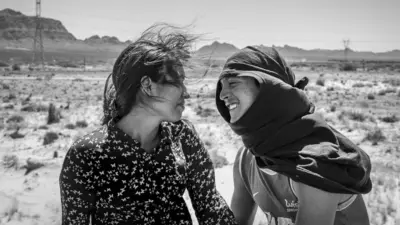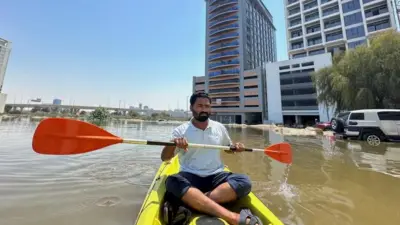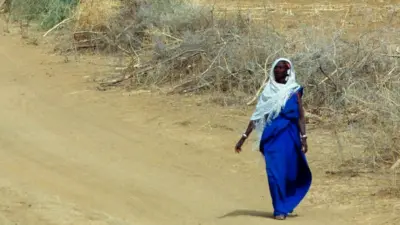We've updated our Privacy and Cookies Policy
We've made some important changes to our Privacy and Cookies Policy and we want you to know what this means for you and your data.
Mangrove forests: Photography winners show beauty of ecosystems
Musfiqur Rahman has been named overall winner of this year's Mangrove Photography Awards, for his image of a wild honey gatherer subduing giant honeybees with smoke, in Bangladesh.
Image source, Musfiqur Rahman
Run by the Mangrove Action Project, the competition - now in its seventh year - aims to show the relationships between wildlife, coastal communities and mangrove forests, as well as the fragility of these unique ecosystems, both above and below the waterline.
Rahman's winning image, A Brave Livelihood, was selected from more than 1,300 entries from 65 countries.
"Indigenous Mowal honey gatherers, protected by Bonbibi, the forest goddess, must evade the dangers (Bengal tigers and saltwater crocodiles) lurking in the mangroves," says Rahman.
"This ancient tradition and sustainable relationship between people and the mangrove forest takes place in the Sundarbans in Bangladesh, and also India."
Mangroves are an important protection against climate change, with one acre (4,000 sq m) of mangrove forest absorbing nearly the same amount of carbon dioxide as an acre of Amazon rainforest.
The forests also protect coastlines from eroding as intense storms grow more frequent.
"Today, less than half the world's original mangrove forest cover remains," says competition judge Robert Irwin.
"It has never been more important to promote the conservation of these fragile ecosystems through inspiring photography."
Here is a selection of winning images from six competition categories, with descriptions by the photographers.
Mangroves & People winner: Mangrove Propagators, by Mark Kevin Badayos, Philippines
Image source, Mark Kevin Badayos
The sun sets on a stretch of coastline after a mangrove restoration and beach clean took place within the local community.
Mangroves & People runner-up: Kayaking at Al Reem Island, by Hooreya Al Muflahi, UAE
Image source, Hooreya Al Muflahi
Enchanted by the mangroves during a kayaking trip, we put the drone up to get a different perspective to reveal the perfectly calm blue water between the mangroves.
Mangroves & People highly commended: Work in Progress, by Abhijit Chakraborty, India
Image source, Abhijit Chakraborty
As climate change and sea level rise threaten the future of the Sundarbans, building dams and mangrove beds is becoming one of the last hopes for the people here.
Mangroves & Landscape winner: Autumn Tree, by Zohaib Anjum, UAE
Image source, Zohaib Anjum
Most of the mangroves along UAE's coastline are found in Abu Dhabi, acting as a "green lung" for the city.
Mangroves & Landscape runner-up: Mangroves at Dawn, by Melodi Roberts, USA
Image source, Melodi Roberts
A peaceful early morning moment at the Merritt Island National Wildlife Refuge in Florida.
Mangroves & Landscape highly commended: Shining Stars above Mangrove Tree, by Yusuf Bin Madi, Malaysia
Image source, Yusuf Bin Madi
The Milky Way shining above a mangrove tree at Mersing Beach, Pulau Mawar, Malaysia, an area only accessible by foot at low tide.
Mangroves & Wildlife winner: Adaptation of Bengal Tiger, by Arijit Das, India
Image source, Arijit Das
After four days of tracking the elusive Bengal tiger, we were finally able to predict where this individual might cross a creek.
Mangroves & Wildlife runner-up: Dancing Mudskipper, by Leo Liu, Taiwan
Image source, Leo Liu
The two mudskippers were stunned during a fight for territory, by a playful dancing individual.
These amphibious fish live in mudflats and connected mangrove ecosystems.
Mangroves & Underwater winner: Shelter, by Shane Gross, Bahamas
Image source, Shane Gross
The green sea turtle is taking shelter in the mangroves.
Green turtles are born on beaches, grow up in the open ocean, eat seagrass and hide in mangroves and coral reefs.
Protecting these ecosystems is essential in protecting these species.
Mangroves & Underwater runner-up: A Rare and Occasional Encounter, by Lorenzo Mittiga, Netherlands Antilles
Image source, Lorenzo Mittiga
A rare encounter with a sargassum frogfish out of its natural habitat.
The frogfish is normally associated with sargassum seaweed, floating and travelling on the algae for thousands of miles from the Atlantic Ocean.
Mangroves & Underwater highly commended: Upside-down Jellyfish in the Mangrove, by Lorenzo Mittiga, Netherlands Antilles
Image source, Lorenzo Mittiga
Mangrove habitats are crucial for many different sea creatures, including the fascinating and colourful upside-down jellyfish.
Mangroves & Threats winner: Garbage on Mangroves, by Mark Kevin Badayos, Philippines
Image source, Mark Kevin Badayos
The plastic problem in this part of the world is huge, and the mangroves are threatened, and slowly suffocating in plastic waste.
Mangroves & Threats runner-up: Broken Mangrove, by Dhany Darmansyah Saragih, Indonesia
Image source, Dhany Darmansyah Saragih
Local people cut down mangrove trees for fuel and building materials for boats and houses.
Over the past three decades, Indonesia has lost 40% of its mangroves.
Mangroves & Threats highly commended: The Reflected Threat, by Marcelo Costa Soares, Brazil
Image source, Marcelo Soares
The image in the photo shows the reflection of the biggest threat to Brazil's largest urban mangrove swamp: real estate speculation in areas of environmental preservation.
Mangroves & Youth winner: Coastal Phantom, by Caleb Hoover, USA
Image source, Caleb Hoover
A clapper rail darts for cover in a patch of coastal red mangroves.
The elusive bird has not been sighted in the area in over six years, but this one has found safety and solitude in a small stretch of mangroves on the coast of Florida.
Mangroves & Youth runner-up: What's Popping? by Lucas Oh Hao Xiang, Singapore
Image source, Lucas Oh Hao Xiang
Mangroves are essential for reptiles, like this Malayan water monitor, to thrive in the limited coastal green spaces of the city.
All pictures are subject to copyright.
Top Stories
Features & Analysis
Most read
Content is not available








